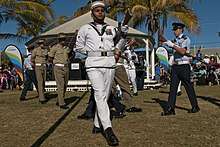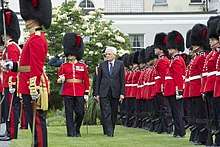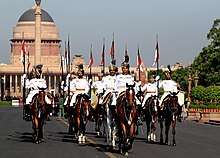Household Division
Household Division is a term used principally in the Commonwealth of Nations to describe a country's most elite or historically senior military units, or those military units that provide ceremonial or protective functions associated directly with the head of state.
Historical development
In medieval Western Europe, the most able warriors were pressed into service as the personal bodyguards to the monarch and other members of the royal or imperial household; as a result, Household troops are commonly referred to as Guards. From this origin developed the practice of designating a country's finest military units as forming Household or Guards regiments.
Members of the Household Divisions would accompany the monarch to protect him when he ventured into the public. Hence, as kingdoms grew larger and more politically complex, the Household Divisions naturally became part of the public spectacle of the state. Their uniforms, weapons and even personal attributes such as height were selected to engender awe on ceremonial occasions. The Household Divisions thus developed a tradition of providing a theatrical ceremonial accompaniment to important national events.
The prestige of serving directly with the monarch created an incentive for the Household Divisions to become dominated by members of the upper classes, irrespective of their actual skills as soldiers. From this development comes the association of Household Divisions with wealth, snobbery, and discrimination, which persisted until the middle of the 20th century.[1]
Today, members of the remaining Household Divisions continue to enjoy a certain social prestige within the armed forces and the state at large. They do, however, continue to fulfil their ceremonial roles at state occasions, and to uphold the more enduring traditions of military service.
Household Divisions throughout the Commonwealth
Australia

The household division concept is not applied in Australia, with the Australian Defence Force operating only one guard unit. In 2000, during the commemoration of the centenary of Australian federation, the Australian Defence Force established Australia's Federation Guard, the first ceremonial unit in the force's history.
The unit performs at commemorative and ceremonial events with national significance as a guard of honour. The unit is a ceremonial unit, and does not have a protective role for the head of state. The unit draws its members from all three service branches of the Australian Defence Force. Although the unit maintains the only drum corp in the force, Australia's Federation Guard relies on the bands of other Australian military units for full musical support.
Canada
The Household Division of Canada (French: Division des ménages) are the most senior armoured and infantry regiments of the Canadian Army Reserve. There are two Canadian household Foot Guards—the Governor General's Foot Guards and the Canadian Grenadier Guards—while the Governor General's Horse Guards is Canada's sole household cavalry regiment.

The Governor General's Horse Guards is the most senior armoured Army Reserve regiment, while the Governor General's Foot Guards and the Canadian Grenadier Guards are, respectively, the first and second most senior infantry Army Reserve regiments. The Governor General's Foot Guards and the Canadian Grenadier Guards have traditionally formed the ad hoc Ceremonial Guard unit, although membership into the Ceremonial Guard had since been opened to other Regular Force and Reserve Force personnel from the Canadian Armed Forces. In addition to supplementing the Ceremonial Guards, other public duties performed by the Foot Guards includes trooping their regimental colour each year at Trooping the Colour on the grounds of Parliament Hill on Victoria Day.
Prior to 1970, the four Regular Force battalions of the Canadian Guards provided the infantry element of the Household Division. In 1970, the Canadian Guards was reduced to nil-strength and moved to the Supplementary Order of Battle; with the infantry element of the Household Division assigned to the most senior infantry regiments of the Army Reserve. Before the establishment of the regiment in the 1950s, the CGG and the GGFG were together informally known as "His Majesty's Brigade of Canadian Guards". In early 2019, as a result of discussions on new military berets for units, the Foot Guard adopted khaki berets as a way to highlight their status as the infantry component of the Household Division in Canada while following the British precedent adopted in the 1970s.[2]
India

Although India is a republic, its history as an empire within the British Empire has left it with a host of institutions of quasi-imperial forms. As a result, the Indian Armed Forces retains a Household Division, despite recognising the authority of no royal household, with a regiment each representing the infantry and cavalry of the Army. The Brigade of the Guards was once the most senior line infantry regiment, before it was changed into a mechanised infantry unit. However, the unit is still recognised as the Indian Army's most senior infantry regiment and is recognized as first in the order of precedence. The brigade was formally established in 1949, and includes three oldest infantry battalions in the Indian Army.
The President's Bodyguard was established in 1773 as the Governor's Troop of Moghuls, and is the only Household Cavalry regiment in the Indian Army. The unit was renamed in 1784, 1859, 1944, and 1946, before it adopted its present name in 1950.
Unlike the Foot Guards but more like the Household Cavalry, these two regiments recruit nationally with officers and other ranks coming from every corner of India regardless of caste, religion and language.
Malaysia
The Malaysian Army maintains an administrative Household Division, made up of the Royal Malay Regiment and the Malaysian Royal Armoured Corps Mounted Ceremonial Squadron. The Royal Malay Regiment serves as the Household Regiment of the Yang di-Pertuan Agong and the Raja Permasuri Agong (King and Queen of Malaysia), together with Royal Armoured Corps Mounted Ceremonial Squadron, which serve as the ceremonial royal cavalry escort unit. Their responsibilities are at the Istana Negara, Kuala Lumpur as the Royal Household Troops and Guards.
Given the large size of the Royal Malaysian Regiment as the senior regiment of the Malaysian infantry, the ceremonial responsibility of Foot Guards are the permanent duties of the unit's 1st Battalion. While the 1st Battalion RMR recruits only Malays, the Mounted Ceremonial Squadron is a multiracial formation, with Malay, Indian, Chinese and Orang Asli servicemen.
United Kingdom

In the United Kingdom, the Household Division consists of seven regiments, giving rise to the division's motto of septem juncta in uno (Latin for "seven joined in one"):
- Household Cavalry (composed of the Life Guards and the Blues and Royals)
- Foot Guards (composed of the Grenadier Guards, the Coldstream Guards, the Scots Guards, the Irish Guards, and the Welsh Guards)
The seven regiments that form the Household Division in the United Kingdom are all currently units of the regular army. From 1950 to 1968, the term Household Brigade was used. In 2004, the Minister of Defence announced that the Foot Guards would gain a reserve (or Territorial Army) battalion, the London Regiment.
They are under the command of the Major-General Commanding the Household Division, who is also General Officer Commanding London District. The Divisional command is made up of the Major General, his Chief of Staff (usually a Colonel), the Brigade Major (usually a Lieutenant Colonel), the Staff Captain, Staff Officer Ceremonial, Superintending Clerk and the Garrison Sergeant Major. In addition, both the Household Cavalry and the Foot Guards have their own chains of command, as do the individual regiments.[3]
The connection with the Sovereign remains important ceremonially, and the Household Division provides ceremonial for the Crown. The Sovereign is Colonel-in-chief of all the constituent regiments of the Division. One of the five Foot Guards regiments is selected each year to troop their colour before the Sovereign at Trooping the Colour annually in June. This ceremony includes march-pasts in slow and quick time, and is attended by the Household Troops. Orders for the Household Division are conveyed to the Major-General via officers who are part of the Royal Household: the Field Officer in Brigade Waiting (for the Foot Guards) and the Silver Stick in Waiting (for the Household Cavalry).
The Foot Guards provide two battalions and incremental companies at any one time tasked for public duties together with the Household Cavalry Mounted Regiment.
References
- "Oldest regiment serves dual role". BBC News. 25 January 2006. Retrieved 21 April 2006.
- Government of Canada, National Defence (2019-04-15). "Article | Army returns to dark blue or khaki berets for Foot Guards and technical corps". www.army-armee.forces.gc.ca. Retrieved 2019-04-24.
- The Division Today (Guards Museum)
External links
- AU – Australia’s Federation Guard (AFG)
- CA – The Canadian Grenadier Guards
- CA – The Governor General’s Foot Guards
- CA – The Governor General’s Horse Guards
- IN – The Brigade of the Guards
- IN – The President's Bodyguard
- UK - British Army Music
- UK – HQ Household Division
- UK – The Household Cavalry
- UK – The King's Troop, Royal Horse Artillery